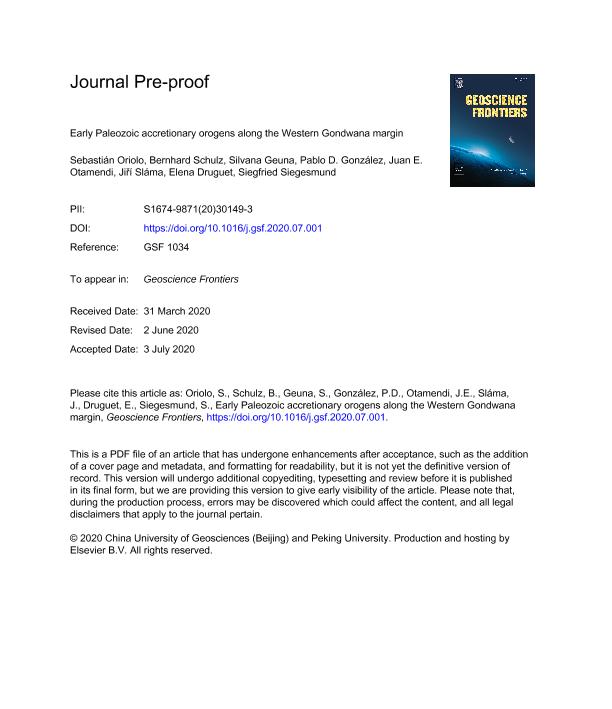Artículo
Early Paleozoic accretionary orogens along the Western Gondwana margin
Oriolo, Sebastián ; Schulz, Bernhard; Geuna, Silvana Evangelina
; Schulz, Bernhard; Geuna, Silvana Evangelina ; Gonzalez, Pablo Diego
; Gonzalez, Pablo Diego ; Otamendi, Juan Enrique
; Otamendi, Juan Enrique ; Sláma, Jiří; Druguet, Elena; Siegesmund, Siegfried
; Sláma, Jiří; Druguet, Elena; Siegesmund, Siegfried
 ; Schulz, Bernhard; Geuna, Silvana Evangelina
; Schulz, Bernhard; Geuna, Silvana Evangelina ; Gonzalez, Pablo Diego
; Gonzalez, Pablo Diego ; Otamendi, Juan Enrique
; Otamendi, Juan Enrique ; Sláma, Jiří; Druguet, Elena; Siegesmund, Siegfried
; Sláma, Jiří; Druguet, Elena; Siegesmund, Siegfried
Fecha de publicación:
01/2021
Editorial:
Elsevier B.V.
Revista:
Geoscience Frontiers
ISSN:
1674-9871
Idioma:
Inglés
Tipo de recurso:
Artículo publicado
Clasificación temática:
Resumen
Early Paleozoic accretionary orogens dominated the Western Gondwana margin and were characterized by nearly continuous subduction associated with crustal extension and back-arc basin development. The southwestern margin is represented by Famatinian and Pampean basement realms exposed in South America, both related to the protracted Paleozoic evolution of the Terra Australis Orogen, whereas the northwestern margin is mainly recorded in Cadomian domains of Europe and adjacent regions. However, no clear relationships between these regions were so far established. Based on a compilation and reevaluation of geological, paleomagnetic, petrological, geochronological and isotopic evidence, this contribution focuses on crustal-scale tectonic and geodynamic processes occurring in Western Gondwana accretionary orogens, aiming at disentangling their common Early Paleozoic evolution. Data show that accretionary orogens were dominated by high-temperature/low-pressure metamorphism and relatively high geothermal gradients, resulting from the development of extended/hyperextended margins and bulk transtensional deformation. In this sense, retreating-mode accretionary orogens characterized the Early Paleozoic Gondwana margin, though short-lived pulses of compression/transpression also occurred. The existence of retreating subduction zones favoured mantle-derived magmatism and mixing with relatively young (meta)sedimentary sources in a thin continental crust. Crustal reworking of previous forearc sequences due to trenchward arc migration thus took place through assimilation and anatexis in the arc/back-arc regions. Therefore, retreating-mode accretionary orogens were the locus of Early Paleozoic crustal growth in Western Gondwana, intimately associated with major flare-up events, such as those related to the Cadomian and Famatian arcs. Slab roll back, probably resulting from decreasing convergence rates and plate velocities after Gondwana assembly, was a key factor for orogen-scale geodynamic processes. Coupled with synchronous oblique subduction and crustal-scale dextral deformation, slab roll back might trigger toroidal mantle flow, thus accounting for bulk dextral transtension, back-arc extension/transtension and a large-scale anticlockwise rotation of Gondwana mainland.
Archivos asociados
Licencia
Identificadores
Colecciones
Articulos (ICBIA)
Articulos de INSTITUTO DE CIENCIAS DE LA TIERRA, BIODIVERSIDAD Y AMBIENTE
Articulos de INSTITUTO DE CIENCIAS DE LA TIERRA, BIODIVERSIDAD Y AMBIENTE
Citación
Oriolo, Sebastián; Schulz, Bernhard; Geuna, Silvana Evangelina; Gonzalez, Pablo Diego; Otamendi, Juan Enrique; et al.; Early Paleozoic accretionary orogens along the Western Gondwana margin; Elsevier B.V.; Geoscience Frontiers; 12; 1; 1-2021; 109-130
Compartir
Altmétricas



